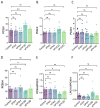Lipidomic Profile Analysis of Lung Tissues Revealed Lipointoxication in Pulmonary Veno-Occlusive Disease
- PMID: 36551306
- PMCID: PMC9775349
- DOI: 10.3390/biom12121878
Lipidomic Profile Analysis of Lung Tissues Revealed Lipointoxication in Pulmonary Veno-Occlusive Disease
Abstract
Pulmonary veno-occlusive disease (PVOD) is a rare form of pulmonary arterial hypertension (PAH) occurring in a heritable form (hPVOD) due to biallelic inactivating mutations of EIF2AK4 (encoding GCN2, general control nonderepressible 2) or in a sporadic form in older age (sPVOD), following exposure to chemotherapy or organic solvents. In contrast to PAH, PVOD is characterized by a particular remodeling of the pulmonary venous system and the obliteration of small pulmonary veins by fibrous intimal thickening and patchy capillary proliferation. The pathobiological knowledge of PVOD is poor, explaining the absence of medical therapy for PVOD. Lung transplantation remains the only therapy for eligible PVOD patients. As we recently demonstrated, respiratory diseases, chronic obstructive pulmonary disease, or cystic fibrosis exhibit lipointoxication signatures characterized by excessive levels of saturated phospholipids contributing to the pathological features of these diseases, including endoplasmic reticulum stress, pro-inflammatory cytokines production, and bronchoconstriction. In this study, we investigated and compared the clinical data and lung lipid signature of control (10 patients), idiopathic PAH (7 patients), heritable PAH (9 BMPR2 mutations carriers), hPVOD (10 EIF2AK4 mutation carriers), and sPVOD (6 non-carriers) subjects. Mass spectrometry analyses demonstrated lung lipointoxication only in hPVOD patients, characterized by an increased abundance of saturated phosphatidylcholine (PC) at the expense of the polyunsaturated species in the lungs of hPVOD patients. The present data suggest that lipointoxication could be a potential player in the etiology of PVOD.
Keywords: PVOD; lysophosphatidylcholine; phospholipids.
Conflict of interest statement
The sponsors had no role in the design, collection, analysis, or interpretation of data, the writing of this article, or the decision to submit it for publication. M.H. and D.M. have relationships with specific drug companies, including Actelion, Bayer, GSK, Novartis, and Pfizer. In addition to being investigators in trials involving these companies, other relationships include consultancy services and memberships on scientific advisory boards. The other authors declare no conflicts of interest.
Figures


References
-
- Ramanadham S., Bohrer A., Mueller M., Jett P., Gross R.W., Turk J. Mass Spectrometric Identification and Quantitation of Arachidonate-Containing Phospholipids in Pancreatic Islets: Prominence of Plasmenylethanolamine Molecular Species. Biochemistry. 1993;32:5339–5351. doi: 10.1021/bi00071a009. - DOI - PubMed
-
- Kadri L., Ferru-Clément R., Bacle A., Payet L.-A., Cantereau A., Hélye R., Becq F., Jayle C., Vandebrouck C., Ferreira T. Modulation of Cellular Membrane Properties as a Potential Therapeutic Strategy to Counter Lipointoxication in Obstructive Pulmonary Diseases. Biochim. Biophys. Acta Mol. Basis Dis. 2018;1864:3069–3084. doi: 10.1016/j.bbadis.2018.06.021. - DOI - PubMed
Publication types
MeSH terms
Substances
LinkOut - more resources
Full Text Sources
Research Materials
Miscellaneous

